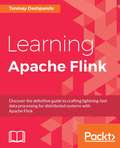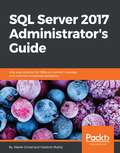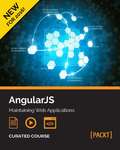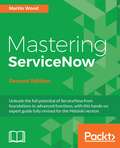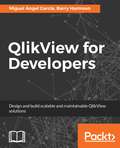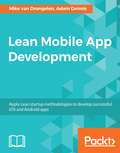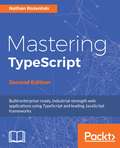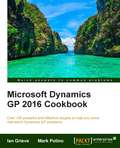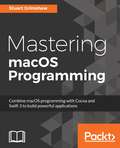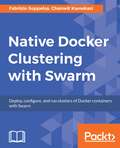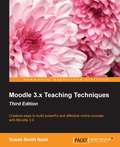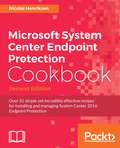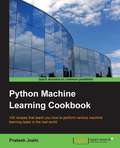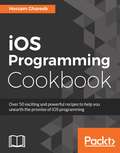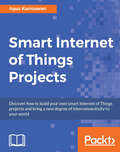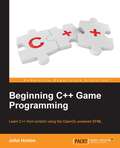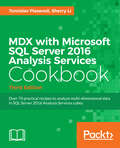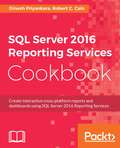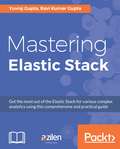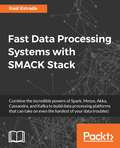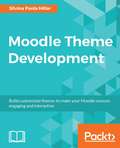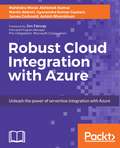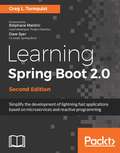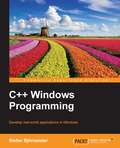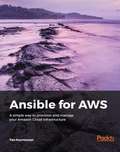- Table View
- List View
Mastering Apache Flink
by Tanmay DeshpandeBig data developers who are looking to process batch and real-time data on distributed systems. Basic knowledge of Hadoop and big data is assumed. Reasonable knowledge of Java or Scala is expected.
SQL Server 2017 Administrator's Guide
by Marek Chmel Vladimir MuznyImplement and administer successful database solution with SQL Server 2017 About This Book • Master the required skills to successfully set up, administer, and maintain your SQL Server 2017 database solution • Design and configure, manage, and secure a rock-solid SQL server • Comprehensive guide in keeping your SQL server disaster proof and all-time availability Who This Book Is For This book targets database administrators with an interest in SQL Server 2017 administration. Readers are expected to have some experience with previous SQL Server versions. What You Will Learn • Learn about the new features of SQL Server 2017 and how to implement them • Build a stable and fast SQL Server environment • Fix performance issues by optimizing queries and making use of indexes • Perform a health check of an existing troublesome database environment • Design and use an optimal database management strategy • Implement efficient backup and recovery techniques in-line with security policies • Combine SQL Server 2017 and Azure and manage your solution by various automation techniques Perform data migration, cluster upgradation and server consolidation In Detail Take advantage of the real power of SQL Server 2017 with all its new features, in addition to covering core database administration tasks. This book will give you a competitive advantage by helping you quickly learn how to design, manage, and secure your database solution. You will learn how to set up your SQL Server and configure new (and existing) environments for optimal use. After covering the designing aspect, the book delves into performance-tuning aspects by teaching you how to effectively use indexes. The book will also teach you about certain choices that need to be made about backups and how to implement a rock-solid security policy and keep your environment healthy. Finally, you will learn about the techniques you should use when things go wrong, and other important topics - such as migration, upgrading, and consolidation - are covered in detail. Integration with Azure is also covered in depth. Whether you are an administrator or thinking about entering the field, this book will provide you with all the skills you need to successfully create, design, and deploy databases using SQL Server 2017. Style and approach A comprehensive guide for database professionals, covering a wide range of topics from installation, maintenance, and configuration to managing systems for operational efficiency and high availability; best practices for maintaining a highly reliable database solution are also supplied from industry experts.
AngularJS: Maintaining Web Applications
by Rodrigo Branas Amos Q. Haviv Matt Frisbie ChandermaniGet started with speed building AngularJS applications, and scale up to a full-stack web application, using the existing AngularJS framework without the trouble of migrating to Angular 2 About This Book • Follow the best practices of the framework to organize and modularize your application • Get to grips with Angular's Model-View-Controller architecture • Create application modules with maximum reusability and extensibility • Structure and use AngularJS applications in your MEAN project Who This Book Is For This course is for people who want to discover how they can improve their current web applications with the existing version of Angular without having to worry much about migrating to AngularJS 2. What You Will Learn • Install and set up the AngularJS framework • Create your own full-featured and robust AngularJS web apps • Create reusable directives and then extend the behavior of HTML on your web page • Master the most difficult aspects of AngularJS such as animation, testing, and promises • Optimize and maintain your web applications • Create more powerful full-stack web applications, that draw on the combined power of AngularJS, Node.js, MongoDB, and Express in the MEAN stack In Detail The AngularJS course is a journey to help you improve and scale your current web applications with the existing version of Angular without having to worry about migration to Angular 2. The course is divided into four modules. The first part—AngularJS Essentials is like a practical guide, filled with many step-by-step examples that will lead you through the best practices of AngularJS. After a brief introduction, you will learn how to create reusable components with directives. You will then take a look at many data handling techniques, discover a complete set of technologies that are capable to accomplish any challenge related to present, transform, and validate data on the user's interface. Finally, you will discover the best way to deal with the scope and how to break up the application into separate modules, giving rise to reusable and interchangeable libraries. With this you've crossed a milestone and are about to enter the world of learning by example. In the next part—Learning AngularJS By Example, you will learn how to effectively build apps using the AngularJS platform. You will be building multiple apps on this platform ranging from simple ones to more complex ones. In this module, you will roll up your coding sleeves and create a serious AngularJS application by example – a rich featured workout app. Take the coding a step at a time at first, then once you're coding a full app in this module, a lot of AngularJS will fall right into place for you. The third module—AngularJS Web Application Development Cookbook, will get you accustomed to the AngularJS concept armed with a solid understanding of how it works, insight into the best ways to wield it in real-world applications, and annotated code examples. It is a rich library of AngularJS coding solutions that you can use straight away in your own code projects. You can even improve and maintain the workout app you built in the earlier module in this course. You are just a step away from completing this learning path of AngularJS. The name of the next part—MEAN Web Development itself assures that you are nearing the destination. The idea is simple with this part, you'll take MongoDB as the database, Express as the web framework, AngularJS as the frontend framework, and Node.js as the platform, and combine them together in a modular approach that will ensure the flexibility needed in modern software development. This is also your graduation to full-stack web development, which can open many new coding and career opportunities for you! Style and approach Get up to speed building AngularJS applications, then improve and scale full-stack web applications, using the existing AngularJS framework without the trouble of migrating to Angular 2
Mastering ServiceNow - Second Edition
by Martin WoodUnleash the full potential of ServiceNow from foundations to advanced functions, with this hands-on expert guide fully revised for the Helsinki version About This Book * Give your ServiceNow Helsinki implementation a powerful kick-start by understanding the deep capabilities of the platform, * Learn by doing with an extended, comprehensive example, creating a feature-rich, secure and automated application from the ground up * Interact with your whole organization by integrating with REST web services and build a custom Service Portal interface Who This Book Is For This book is aimed at advanced ServiceNow System Administrators and developers who would like to gain greater control of ServiceNow and its architecture. The book expects you to be new to ServiceNow, but have a good grounding in internet and computing technologies, like HTML, JSON, REST and database systems. Readers should be especially familiar with JavaScript, and be keen to extend and alter the platform. With this book, they will be able to develop a new application for their company. What You Will Learn * Build custom scoped applications that access the full ServiceNow API * Build a modern, responsive self-service interface with Service Portal * Design feature-rich, responsive, automated workflow systems * Design powerful data-driven applications * Control information flow and apply business logic with Business Rules * Write efficient and effective client-side JavaScript * Learn how to authenticate and secure Web Services * Integrate and exchange data with people and systems * Create and secure your systems with proper access control In Detail ServiceNow is a SaaS application that provides workflow form-based applications. It is an ideal platform for creating enterprise-level applications giving requesters and fulfillers improved visibility and access to a process. ServiceNow-based applications often replace email by providing a better way to get work done. The book steps through the main aspects of the ServiceNow platform, from the ground up. It starts by exploring the core architecture of ServiceNow, including building the right data structure. To add business logic and control data, and interactivity to user interaction, you will be shown how to code on both server and the client. You will then learn more about the power of tasks, events and notifications. The book will then focus on using web services and other mechanisms to integrate ServiceNow with other systems. Furthermore, you will learn how to secure applications and data, and understand how ServiceNow performs logging and error reporting. You will then be shown how to package your applications and changes, so they can be installed elsewhere and ways to maintain them easily. If you wish to create an alternative simple interface, then explore ways to make ServiceNow beautiful using Service Portal. By the end of the book, you will know the fundamentals of the ServiceNow platform, helping you be a better ServiceNow System Administrator or developer. Style and approach Explore how to implement business logic and automated workflows and write effective code by flexible choices for client-side scripting
QlikView for Developers
by Miguel Angel Garcia Barry HarmsenDrive value and insight by developing business critical applications with QlikView 12 About This Book • Develop your own scalable and maintainable QlikView applications • Learn time-saving techniques for making your QlikView development more efficient • A one-stop guide to developing BI applications with QlikView Who This Book Is For This book is for anyone interested in working with QlikView or who has attended QlikView Developer training. The book caters for all QlikView developers, beginners and experts alike, and anyone who wants to improve their QlikView skills. What You Will Learn • Understand important changes made in QlikView 12 • Learn the techniques and best practices to transform data in QlikView via scripts • Load data from disparate sources to build an associative Data Model • Build robust data models and overcome common modeling challenges • Designing data visualization objects to present performance measures with charts and tables • Learn to use dimensions and expressions in QlikView objects • Utilize QlikView's built-in aggregation functions to achieve complex calculations • Create Point In Time reporting and achieving complex calculations using Set Analysis • Create a consistent and interactive user interface • Ensure your QlikView applications and data are protected • Optimize the QlikView Data Model • Constructing a data architecture that supports scalable QlikView deployments • Learn time-saving techniques for making your QlikView development more efficient In Detail QlikView is one of the most flexible and powerful Business Intelligence platforms around. If you want to build data into your organization, build it around QlikView. Don't get caught in the gap between data and knowledge – find out how QlikView can help you unlock insights and data potential with ease. Whether you're new to QlikView or want to get up to speed with the features and functionality of QlikView, this book starts at a basic level and delves more deeply to demonstrate how to make QlikView work for you, and make it meet the needs of your organization. Using a real-world use-case to highlight the extensive impact of effective business analytics, this book might well be your silver bullet for success. A superb hands-on guide to get you started by exploring the fundamentals of QlikView before learning how to successfully implement it, technically and strategically. You'll learn valuable tips, tricks, and insightful information on loading different types of data into QlikView, and how to model it effectively. You will also learn how to write useful scripts for QlikView to handle potentially complex data transformations in a way that is simple and elegant. From ensuring consistency and clarity in your data models, to techniques for managing expressions using variables, this book makes sure that your QlikView projects are organized in a way that's most productive for you and key stakeholders. Style and approach This book will help you learn QlikView Development from a basic to a practitioner level using a step-by-step approach. It is smartly built around a practical case study – HighCloud Airlines – to help you gain an in-depth understanding of how to build applications for Business Intelligence using QlikView.
Lean Mobile App Development
by Alberto Gonzalez Mike Van Drongelen Adam Dennis Richard Garabedian Aravind KrishnaswamyDevelop lean iOS and Android apps using industry standard techniques and lean development practices. About This Book • Build ready-to-deploy apps with less iterations and shorter development times • Adopt the lean startup methodologies to develop iOS and Android apps that shine in the App Store • This hands-on guide puts continuous innovation into practice to develop successful mobile apps Who This Book Is For This book is for developers, CTOs, and architects working for a startup or another kind of lean startup environment, such as start-up within a cooperation. It is is ideal for any iOS and Android developer who wants to build successful mobile apps by adopting the lean startup methodology. What You Will Learn • Apply the lean startup methodology to real Android and iOS development • Define what your hypotheses are by creating an Minimal Viable Product • Validate your idea against the Business Model Canvas • Gather feedback through statistics and by getting user comments, learn from it, and adapt your app accordingly • Develop skills and devise strategies to build versatile and flexible apps that meet changing business requirements • Investigate the possibilities when you need to pivot your start-up idea whether in a startup or an established business. • Create a successful app and get tips on how to boostconversion and how to optimize the on boardingprocess. In Detail Lean is the ultimate methodology for creating a startup that succeeds. Sounds great from a theoretical point of view, but what does that mean for you as an a technical co-founder or mobile developer? By applying the Lean Start-up methodology to your mobile App development, it will become so much easier to build apps that take Google Play or the App Store by storm. This book shows you how to bring together smarter business processes with technical know-how. It makes no sense to develop a brilliant app for six months or longer only to find out later that nobody is interested in it. Build a Minimum Viable Product (MVP) first. Validate your hypotheses early and often. Discover effective product development strategies that let you put Facebook's famous axiom "move fast and break things" into practice. A great app without visibility and marketing clout is nothing, so use this book to market your app, making use of effective metrics that help you track and iterate all aspects of project performance. Style and approach This book takes a hands-on approach to developing apps through the Lean Start-up Methodology. Following a 50% business and 50% tech approach, this book is filled with practical examples and real-world experiments.
Mastering TypeScript - Second Edition
by Nathan RozentalsWhether you are a JavaScript developer who wants to learn TypeScript or an experienced TypeScript developer who wants to take your skills to the next level, this book is for you. If you are an enterprise JavaScript developer who builds web sites using Backbone, Marionette, Angular, Angular 2, Aurelia, or React.js, then this book will make you a better, more productive programmer.
Microsoft Dynamics GP 2016 Cookbook - Second Edition
by Ian Grieve Mark PolinoThe book is for Dynamics GP users or Dynamics GP partners. It assumes that you have a basic understanding of business management systems and Microsoft Dynamics GP.
Mastering macOS Programming
by Stuart GrimshawThis book is for developers who have some experience with macOS and want to take their skills to next level by unlocking the full potential of latest version of macOS with Swift 3 to build impressive applications. Basic knowledge of Swift will be beneficial but is not required.
Native Docker Clustering with Swarm
by Chanwit Kaewkasi Fabrizio SoppelsaDeploy, configure, and run clusters of Docker containers with Swarm About This Book • Get to grips with Docker Swarm, one of the key components of the Docker ecosystem. • Optimize Swarm and SwarmKit features for scaling massive applications through containers. • Learn about Docker's scheduling tricks, high availability, security, and platform scalability. Who This Book Is For If you are a Linux admin or a Docker user who wants to natively manage Docker clusters, then this is the book for you. What You Will Learn • Create and manage Swarm Mode clusters of any size • Get a backstage view of the biggest Swarms ever built : Swarm2k and Swarm3k, with their 2,300 and 4,700 nodes • Discovery mechanisms and Raft • Deploy your containerized app on Swarm • Administer Swarm clusters on AWS, Azure, and DigitalOcean • Integrate Flocker volumes with Swarm • Create and manage Swarms on OpenStack Magnum In Detail Docker Swarm serves as one of the crucial components of the Docker ecosystem and offers a native solution for you to orchestrate containers. It's turning out to be one of the preferred choices for Docker clustering thanks to its recent improvements. This book covers Swarm, Swarm Mode, and SwarmKit. It gives you a guided tour on how Swarm works and how to work with Swarm. It describes how to set up local test installations and then moves to huge distributed infrastructures. You will be shown how Swarm works internally, what's new in Swarmkit, how to automate big Swarm deployments, and how to configure and operate a Swarm cluster on the public and private cloud. This book will teach you how to meet the challenge of deploying massive production-ready applications and a huge number of containers on Swarm. You'll also cover advanced topics that include volumes, scheduling, a Libnetwork deep dive, security, and platform scalability. Style and approach A comprehensive guide that covers all aspects of Docker Swarm from setup to customization.
Moodle 3.x Teaching Techniques - Third Edition
by Susan Smith NashCreative ways to build powerful and effective online courses with Moodle 3.0 About This Book * Unleash your teaching talents and develop exciting, dynamic courses * Put together effective online courses that motivate students from all backgrounds, generations, and learning styles * Find powerful insights into developing more successful and educational courses Who This Book Is For If you want to unleash your teaching talents and develop exciting, dynamic courses that really get students moving forward, then this book is for you. Experienced Moodlers who want to upgrade to Moodle 3.0 will find powerful insights into developing more successful and educational courses. What You Will Learn * Create a dynamic learning environment using different techniques * Motivate your students to collaborate and demonstrate what they are learning and to create projects together * Develop materials you can re-use in your future courses * Create online workshops and galleries for your students to make presentations about what they have learned * Engage your students in team work that helps them connect course content with their experiences and prior learning * Develop high-quality courses that will last to create a personal inventory you can use and re-use In Detail Moodle, the world's most popular, free open-source Learning Management System (LMS) has released several new features and enhancements in its latest 3.0 release. More and more colleges, universities, and training providers are using Moodle, which has helped revolutionize e-learning with its flexible, reusable platform and components. This book brings together step-by-step, easy-to-follow instructions to leverage the full power of Moodle 3 to build highly interactive and engaging courses that run on a wide range of platforms including mobile and cloud. Beginning with developing an effective online course, you will write learning outcomes that align with Bloom's taxonomy and list the kinds of instructional materials that will work given one's goal. You will gradually move on to setting up different types of forums for discussions and incorporating multi-media from cloud-base sources. You will then focus on developing effective timed tests, self-scoring quizzes while organizing the content, building different lessons, and incorporating assessments. Lastly, you will dive into more advanced topics such as creating interactive templates for a full course by focussing on creating each element and create workshops and portfolios which encourage engagement and collaboration Style and approach With clear, step-by-step instructions, this book helps you develop good, solid, dynamic courses that will last by making sure that your instructional design is robust, and that they are built around satisfying learning objectives and course outcomes. Packed with plenty of screenshots and practical examples, you will get solid understanding of developing courses that are a success in the real world.
Microsoft System Center Endpoint Protection Cookbook - Second Edition
by Nicolai HenriksenOver 31 simple yet incredibly effective recipes for installing and managing System Center 2016 Endpoint Protection About This Book • This is the most practical and up-to-date book covering important new features of System Center 2016 Endpoint protection • Gain confidence in managing IT and protecting your server against malware and other threats • Configure and automate reporting features and also prepare yourself for a simple and pain-free migration process Who This Book Is For If you are a System Administrator or Engineer using System Center 2016 Endpoint Protection, then this book is for you. You should have a good background with Microsoft products in general, although no knowledge of Endpoint Protection is required. What You Will Learn • Explore the best practices for Endpoint Protection in System Center Configuration Manager • Provision the Endpoint Protection Client in a Disk Image in Configuration Manager • Get to know more about the Security Center • Configure definition and engine client updates to be optimum for your bandwidth • Make your application or server work with Endpoint Protection enabled • Find out how to deal with typical issues that may occur with Endpoint Protection • Know how to respond to infections that often occur In Detail System Center Configuration Manager is now used by over 70% of all the business in the world today and many have taken advantage engaging the System Center Endpoint Protection within that great product. Through this book, you will gain knowledge about System Center Endpoint Protection, and see how to work with it from System Center Configuration Manager from an objective perspective. We'll show you several tips, tricks, and recipes to not only help you understand and resolve your daily challenges, but hopefully enhance the security level of your business. Different scenarios will be covered, such as planning and setting up Endpoint Protection, daily operations and maintenance tips, configuring Endpoint Protection for different servers and applications, as well as workstation computers. You'll also see how to deal with malware and infected systems that are discovered. You'll find out how perform OS deployment, Bitlocker, and Applocker, and discover what to do if there is an attack or outbreak. You'll find out how to ensure good control and reporting, and great defense against threats and malware software. You'll see the huge benefits when dealing with application deployments, and get to grips with OS deployments, software updates, and disk encryption such as Bitlocker. By the end, you will be fully aware of the benefits of the System Center 2016 Endpoint Protection anti-malware product, ready to ensure your business is watertight against any threat you could face. Style and approach Build robust SCEP and AV policies and discover the new potential of exciting new features of SCEP 2016.
Python Machine Learning Cookbook
by Prateek JoshiThis book is for Python programmers who are looking to use machine-learning algorithms to create real-world applications. This book is friendly to Python beginners, but familiarity with Python programming would certainly be useful to play around with the code.
iOS 10 Programming Cookbook
by Hossam GhareebIf you are an iOS developer on a quest to develop your perfect iOS app, then this book is for you. It would also prove to be a valuable resource for those who want to get up and running with iOS development through a clear, practical approach. In order to unleash the full potential of this book, basic Swift programming knowledge is necessary.
Smart Internet of Things Projects
by Agus KurniawanDiscover how to build your own smart Internet of Things projects and bring a new degree of interconnectivity to your world About This Book • Learn how to extract and analyse data from physical devices and build smart IoT projects • Master the skills of building enticing projects such as a neural network autonomous car, computer vision through a camera, and cloud-based IoT applications • This project-based guide leverages revolutionary computing chips such as Raspberry Pi, Arduino, and so on Who This Book Is For If you are hobbyist who is keen on making smart IoT projects, then this book is for you. You should have a basic knowledge of Python. What You Will Learn • Implement data science in your IoT projects and build a smart temperature controller • Create a simple machine learning application and implement decision system concepts • Develop a vision machine using OpenCV • Build a robot car with manual and automatic control • Implement speech modules with your own voice commands for IoT projects • Connect IoT to a cloud-based server In Detail Internet of Things (IoT) is a groundbreaking technology that involves connecting numerous physical devices to the Internet and controlling them. Creating basic IoT projects is common, but imagine building smart IoT projects that can extract data from physical devices, thereby making decisions by themselves. Our book overcomes the challenge of analyzing data from physical devices and accomplishes all that your imagination can dream up by teaching you how to build smart IoT projects. Basic statistics and various applied algorithms in data science and machine learning are introduced to accelerate your knowledge of how to integrate a decision system into a physical device. This book contains IoT projects such as building a smart temperature controller, creating your own vision machine project, building an autonomous mobile robot car, controlling IoT projects through voice commands, building IoT applications utilizing cloud technology and data science, and many more. We will also leverage a small yet powerful IoT chip, Raspberry Pi with Arduino, in order to integrate a smart decision-making system in the IoT projects. Style and approach The book follows a project-based approach to building smart IoT projects using powerful boards such as the Raspberry Pi, Arduino, and the IoT chip.
Beginning C++ Game Programming
by John HortonLearn C++ from scratch using the OpenGL-powered SFMLAbout This BookThis book offers a fun way to learn modern C++ programming while building exciting 2D gamesThis beginner-friendly guide offers a fast-paced but engaging approach to game developmentDive headfirst into building a wide variety of desktop games that gradually increase in complexityIt is packed with many suggestions to expand your finished games that will make you think critically, technically, and creativelyWho This Book Is ForThis book is for those who have no C++ programming knowledge whatsoever and want to learn to build games or just use games as a more engaging way to learn C++. If you have aspirations of one day publishing a game on Steam or just want to have a load of fun while learning C++, then this book was written for you.What You Will LearnGet to know C++ from scratch while simultaneously learning about building gamesMake C++ game coding appear like it is something that any determined person can doGet a competent level knowledge of C++ programming.Build exciting games with a wide range of featuresGet ready to go and build your own unique gamesIn DetailThis book is all about offering you a fun introduction to the world of game programming and C++. It will begin by teaching you the programming basics such as variables, loops, and conditions using game-like mini apps.We then move on to build actual working games. Throughout the course of the book, you will learn to build three different styles of games comprising a frantic two-button-tapper, a zombie survival/shooter, and a multiplayer platformer. While building these games, you will learn some more C++ programming concepts such as OOP and data storage/complexity. We'll end by creating a multiplayer shooter game and will also introduce you to some of the advanced capabilities of C++ such as networking and advanced OOP.As the games gradually increase in complexity, you will explore some of the advanced capabilities of C++ as well as some exciting new game programming techniques.
MDX with Microsoft SQL Server 2016 Analysis Services Cookbook - Third Edition
by Tomislav Piasevoli Sherry LiOver 70 practical recipes to analyze multi-dimensional data in SQL Server 2016 Analysis Services cubes About This Book * Updated for SQL Server 2016, this book helps you take advantage of the new MDX commands and the new features introduced in SSAS * Perform time-related, context-aware, and business related-calculations with ease to enrich your Business Intelligence solutions * Collection of techniques to write flexible and high performing MDX queries in SSAS with carefully structured examples Who This Book Is For This book is for anyone who has been involved in working with multidimensional data. If you are a multidimensional cube developer, a multidimensional database administrator, or a report developer who writes MDX queries to access multidimensional cube, this book will help you. If you are a power cube user or an experienced business analyst, you will also find this book invaluable in your data analysis. This book is for you are interested in doing more data analysis so that the management can make timely and accurate business decisions. What You Will Learn * Grasp the fundamental MDX concepts, features, and techniques * Work with sets * Work with Time dimension and create time-aware calculations * Make analytical reports compact, concise, and efficient * Navigate cubes * Master MDX for reporting with Reporting Services (new) * Perform business analytics * Design efficient cubes and efficient MDX queries * Create metadata-driven calculations (new) * Capture MDX queries and many other techniques In Detail If you're often faced with MDX challenges, this is a book for you. It will teach you how to solve various real-world business requirements using MDX queries and calculations. Examples in the book introduce an idea or a problem and then guide you through the process of implementing the solution in a step-by-step manner, inform you about the best practices and offer a deep knowledge in terms of how the solution works. Recipes are organized by chapters, each covering a single topic. They start slowly and logically progress to more advanced techniques. In case of complexity, things are broken down. Instead of one, there are series of recipes built one on top of another. This way you are able to see intermediate results and debug potential errors faster. Finally, the cookbook format is here to help you quickly identify the topic of interest and in it a wide range of practical solutions, that is - MDX recipes for your success. Style and approach This book is written in a cookbook format, where you can browse through and look for solutions to a particular problem in one place. Each recipe is short, to the point and grouped by relevancy. All the recipes are sequenced in a logical progression; you will be able to build up your understanding of the topic incrementally.
SQL Server 2016 Reporting Services Cookbook
by Dinesh Priyankara Robert C. CainCreate interactive cross-platform reports and dashboards using SQL Server 2016 Reporting Services About This Book * Get up to speed with the newly-introduced enhancements and the more advanced query and reporting features * Easily access your important data by creating visually appealing dashboards in the Power BI practical recipe * Create cross-browser and cross-platform reports using SQL Server 2016 Reporting Services Who This Book Is For This book is for software professionals who develop and implement reporting solutions using Microsoft SQL Server. It is especially relevant for professionals who are software engineers, software architects, DW/BI engineers, and DW/BI architects who perform simple to complex report authoring implementations. This book is also suitable for those who develop software solutions that integrate reporting solutions and are keen to learn about Microsoft SQL Server 2016's features and capabilities. What You Will Learn * Key capabilities, architecture, and components of Reporting Services * New features that have been added to Reporting Services * Design the architecture for reporting solutions * Design the architecture for BI solutions * Implement reporting solutions using Reporting Services * Improve the performance, availability, and scalability of the reporting solution * Enhance reporting solutions with custom programming and improved security In Detail Microsoft SQL Server 2016 Reporting Services comes with many new features. It offers different types of reporting such as Production, Ad-hoc, Dashboard, Mash-up, and Analytical. SQL Server 2016 also has a surfeit of new features including Mobile Reporting, and Power BI integration. This book contains recipes that explore the new and advanced features added to SQL Server 2016. The first few chapters cover recipes on configuring components and how to explore these new features. You'll learn to build your own reporting solution with data tools and report builder, along with learning techniques to create visually appealing reports. This book also has recipes for enhanced mobile reporting solutions, accessing these solutions effectively, and delivering interactive business intelligence solutions. Towards the end of the book, you'll get to grips with running reporting services in SharePoint integrated mode and be able to administer, monitor, and secure your reporting solution. This book covers about the new offerings of Microsoft SQL Server 2016 Reporting Services in comprehensive detail and uses examples of real-world problem-solving business scenarios. Style and approach This comprehensive cookbook follows a problem-solution approach to help you overcome any obstacle when creating interactive, visually-appealing reports using SQL Server 2016 Reporting Services. Each recipe focuses on a specific task and is written in a clear, solution-focused style.
Mastering ELK Stack
by Yuvraj Gupta Ravi Kumar GuptaThis book cater to developers using the ELK stack in their day-to-day work who are familiar with the basics of Elasticsearch, Logstash, and Kibana, and now want to become an expert at using the ELK stack for data analytics.
Fast Data Processing Systems with SMACK Stack
by Raul EstradaCombine the incredible powers of Spark, Mesos, Akka, Cassandra, and Kafka to build data processing platforms that can take on even the hardest of your data troubles! About This Book • This highly practical guide shows you how to use the best of the big data technologies to solve your response-critical problems • Learn the art of making cheap-yet-effective big data architecture without using complex Greek-letter architectures • Use this easy-to-follow guide to build fast data processing systems for your organization Who This Book Is For If you are a developer, data architect, or a data scientist looking for information on how to integrate the Big Data stack architecture and how to choose the correct technology in every layer, this book is what you are looking for. What You Will Learn • Design and implement a fast data Pipeline architecture • Think and solve programming challenges in a functional way with Scala • Learn to use Akka, the actors model implementation for the JVM • Make on memory processing and data analysis with Spark to solve modern business demands • Build a powerful and effective cluster infrastructure with Mesos and Docker • Manage and consume unstructured and No-SQL data sources with Cassandra • Consume and produce messages in a massive way with Kafka In Detail SMACK is an open source full stack for big data architecture. It is a combination of Spark, Mesos, Akka, Cassandra, and Kafka. This stack is the newest technique developers have begun to use to tackle critical real-time analytics for big data. This highly practical guide will teach you how to integrate these technologies to create a highly efficient data analysis system for fast data processing. We'll start off with an introduction to SMACK and show you when to use it. First you'll get to grips with functional thinking and problem solving using Scala. Next you'll come to understand the Akka architecture. Then you'll get to know how to improve the data structure architecture and optimize resources using Apache Spark. Moving forward, you'll learn how to perform linear scalability in databases with Apache Cassandra. You'll grasp the high throughput distributed messaging systems using Apache Kafka. We'll show you how to build a cheap but effective cluster infrastructure with Apache Mesos. Finally, you will deep dive into the different aspect of SMACK using a few case studies. By the end of the book, you will be able to integrate all the components of the SMACK stack and use them together to achieve highly effective and fast data processing. Style and approach With the help of various industry examples, you will learn about the full stack of big data architecture, taking the important aspects in every technology. You will learn how to integrate the technologies to build effective systems rather than getting incomplete information on single technologies. You will learn how various open source technologies can be used to build cheap and fast data processing systems with the help of various industry examples
Moodle Theme Development
by Silvina Paola HillarBuild customized themes to make your Moodle courses engaging and interactive About This Book * Leverage the power of Moodle 3 to create interactive and engaging themes for your courses * Experience and integrate the power of Bootstrap and CSS into your Moodle app * Implement your plans with illustrative examples to become a top notch designer Who This Book Is For If you are a Moodle administrator, developer, or designer and wish to enhance your Moodle site to make it visually attractive, then this book is for you. You should be familiar with web design techniques such as HTML and further experience with CSS would be helpful. What You Will Learn * Plan a personalized Moodle theme from start to finish * Install a Moodle theme in different operating systems and change Moodle's theme settings * Add your own customized logo and test your changes in several web browsers * Customize the Moodle site to fit in with other elements such as websites and social networks, among others * Create a design mock-up using graphics software * Design themes that are capable of working with a huge number of different resolutions, screen sizes, screen orientations, and pixel densities * Work with code to adjust the theme to users requirements * Create new custom icons for your theme In Detail Theming is one of the main features of Moodle, and it can be used to customize your online courses and make them look exactly how you want them to,according to your target audience. If you have been looking for a book that will help you develop Moodle themes that you are proud of, and that your students will enjoy, then this is the book for you. We start off by introducing Moodle 3 and explaining what it is, how it works, and what tools you might need to create a stunning Moodle theme. We then show you how to choose and change the pre-installed Moodle themes in detailed steps, and explain what Moodle themes are and how they work. Next, we show you how to change an existing theme and test the changes that you have made. You can not only plan the customization of theme, but also tailor it using advanced Moodle theming processes; this book is your one-stop guide to creating your own personalized Moodle 3 theme. Style and approach This book acts as a comprehensive guide which helps you to create visually stunning and responsive themes to add that extra edge to your Moodle apps.
Robust Cloud Integration with Azure
by Abhishek Kumar Gyanendra Kumar Gautam James Corbould Mahindra Morar Martin AbbottUnleash the power of serverless integration with Azure About This Book • Build and support highly available and scalable API Apps by learning powerful Azure-based cloud integration • Deploy and deliver applications that integrate seamlessly in the cloud and quickly adapt as per your integration needs • Deploy hybrid applications that work and integrate on the cloud (using Logic Apps and BizTalk Server) Who This Book Is For This book is for Microsoft Enterprise developers, DevOps, and IT professionals who would like to use Azure App Service and Microsoft Cloud Integration technologies to create cloud-based web and mobile apps. What You Will Learn • Explore new models of robust cloud integration in Microsoft Azure • Create your own connector and learn how to publish and manage it • Build reliable, scalable, and secure business workflows using Azure Logic Apps • Simplify SaaS connectivity with Azure using Logic Apps • Connect your on-premises system to Azure securely • Get to know more about Logic Apps and how to connect to on-premises “line-of-business” applications using Microsoft BizTalk Server In Detail Microsoft is focusing heavily on Enterprise connectivity so that developers can build scalable web and mobile apps and services in the cloud. In short, Enterprise connectivity from anywhere and to any device. These integration services are being offered through powerful Azure-based services. This book will teach you how to design and implement cloud integration using Microsoft Azure. It starts by showing you how to build, deploy, and secure the API app. Next, it introduces you to Logic Apps and helps you quickly start building your integration applications. We'll then go through the different connectors available for Logic Apps to build your automated business process workflow. Further on, you will see how to create a complex workflow in Logic Apps using Azure Function. You will then add a SaaS application to your existing cloud applications and create Queues and Topics in Service Bus on Azure using Azure Portal. Towards the end, we'll explore event hubs and IoT hubs, and you'll get to know more about how to tool and monitor the business workflow in Logic Apps. Using this book, you will be able to support your apps that connect to data anywhere—be it in the cloud or on-premises. Style and approach This practical hands-on tutorial shows you the full capability of App Service and other Azure-based integration services to build scalable and highly available web and mobile apps. It helps you successfully build and support your applications in the cloud or on-premises successfully. We'll debunk the popular myth that switching to cloud is risky—it's not!
Learning Spring Boot 2.0 - Second Edition: Simplify the development of lightning fast applications based on microservices and reactive programming
by Greg L. TurnquistUse Spring Boot to build lightning-fast apps About This Book • Get up to date with the defining characteristics of Spring Boot 2.0 in Spring Framework 5 • Learn to perform Reactive programming with SpringBoot • Learn about developer tools, AMQP messaging, WebSockets, security, MongoDB data access, REST, and more Who This Book Is For This book is designed for both novices and experienced Spring developers. It will teach you how to override Spring Boot's opinions and frees you from the need to define complicated configurations. What You Will Learn • Create powerful, production-grade applications and services with minimal fuss • Support multiple environments with one artifact, and add production-grade support with features • Find out how to tweak your apps through different properties • Use custom metrics to track the number of messages published and consumed • Enhance the security model of your apps • Make use of reactive programming in Spring Boot • Build anything from lightweight unit tests to fully running embedded web container integration tests In Detail Spring Boot provides a variety of features that address today's business needs along with today's scalable requirements. In this book, you will learn how to leverage powerful databases and Spring Boot's state-of-the-art WebFlux framework. This practical guide will help you get up and running with all the latest features of Spring Boot, especially the new Reactor-based toolkit. The book starts off by helping you build a simple app, then shows you how to bundle and deploy it to the cloud. From here, we take you through reactive programming, showing you how to interact with controllers and templates and handle data access. Once you're done, you can start writing unit tests, slice tests, embedded container tests, and even autoconfiguration tests. We go into detail about developer tools, AMQP messaging, WebSockets, security, and deployment. You will learn how to secure your application using both routes and method-based rules. By the end of the book, you'll have built a social media platform from which to apply the lessons you have learned to any problem. If you want a good understanding of building scalable applications using the core functionality of Spring Boot, this is the book for you. Style and approach This book takes a tutorial-based approach to teach you all you need to know to get up and running with the latest version of Spring Boot. Filled with examples, you will gain hands-on experience of every area that Spring tackles.
C++ Windows Programming
by Stefan BjornanderDevelop real-world applications in Windows. About This Book * Create diverse applications featuring the versatility of Small Windows C++ library * Learn about object-oriented programming in Windows and how to develop a large object-oriented class library in C++ * Understand how to tackle application-specific problems along with acquiring a deep understanding of the workings of Windows architecture Who This Book Is For This book is for application developers who want a head-first approach into Windows programming. It will teach you how to develop an object-oriented class library in C++ and enhanced applications in Windows. Basic knowledge of C++ and the object-oriented framework is assumed to get the most out of this book. What You Will Learn * Develop advanced real-world applications in Windows * Design and implement a graphical object-oriented class library in C++ * Get to grips with the workings of the integral aspects of the Win32 API, such as mouse input, drawing, cut-and-paste, file handling, and drop files * Identify general problems when developing graphical applications as well as specific problems regarding drawing, spreadsheet, and word processing applications * Implement classes, functions, and macros of the object-oriented class library developed in the book and how we implement its functionality by calling functions and macros in the Win32 API In Detail It is critical that modern developers have the right tools to build practical, user-friendly, and efficient applications in order to compete in today's market. Through hands-on guidance, this book illustrates and demonstrates C++ best practices and the Small Windows object-oriented class library to ease your development of interactive Windows applications. Begin with a focus on high level application development using Small Windows. Learn how to build four real-world applications which focus on the general problems faced when developing graphical applications. Get essential troubleshooting guidance on drawing, spreadsheet, and word processing applications. Finally finish up with a deep dive into the workings of the Small Windows class library, which will give you all the insights you need to build your own object-oriented class library in C++. Style and approach This book takes a tutorial-style approach that will demonstrate the features of a C++ object-oriented library by developing interactive Windows applications.
Ansible for AWS
by Yan KurniawanA simple way to provision and manage your Amazon Cloud infrastructure About This Book * Get started with AWS management for infrastructure engineers * Explore techniques to set up and manage your private cloud using Ansible * A practical guide to help you manage AWS-based applications and infrastructure using Ansible Who This Book Is For If you are an infrastructure engineer, system administrator, or Dev Ops engineer, this book is for you. You will find this book helpful if you have previous experience with Linux systems administration, including familiarity with the command line, file system, and text editing. Prior basic knowledge of Amazon Web Services and some experience with Ansible is assumed. What You Will Learn * Set up your own AWS account and get started with the AWS console * Use Ansible Playbook to configure and launch EC2 instances * Delve deeper into the AWS cloud infrastructure and create and manage VPC * Provision Amazon Relational Database Service (RDS) with Ansible * Manage files in an Amazon Simple Storage Service (S3) bucket using Ansible * Extend Ansible's functionality in the AWS environment * Use Ansible to provision ELB and Auto Scaling groups * Manage IAM users, groups, roles, and keys * See how to refine and chain together AWS tools using Ansible In Detail Looking to get a simple and efficient way to manage your Amazon Cloud infrastructure? Ansible is exactly what you need. This book will show you how to use Ansible's cloud modules to easily provision and manage AWS resources including EC2, VPC, RDS, S3, ELB, ElastiCache, and Route 53. We'll take you beyond the basics of Ansible, showing you real-world examples of AWS infrastructure automation and management with detailed steps, complete code, and screen captures from the AWS console. The example projects inside this title will help you grasp the process leading to full AWS automation. From a single WordPress site to a highly available and scalable WordPress site, we'll demonstrate the power of using Ansible to provision and automate AWS-based infrastructure deployment. Style and approach This hands-on guide will help you get acquainted with techniques to implement AWS for your private cloud.
